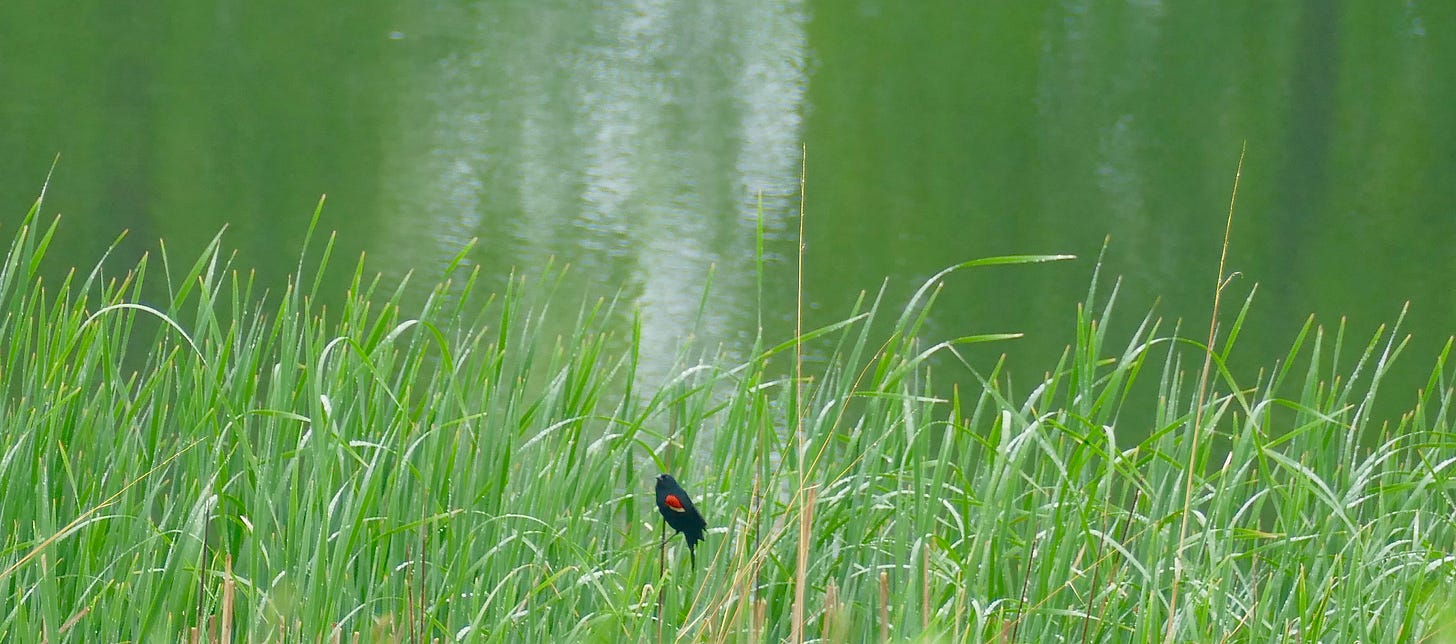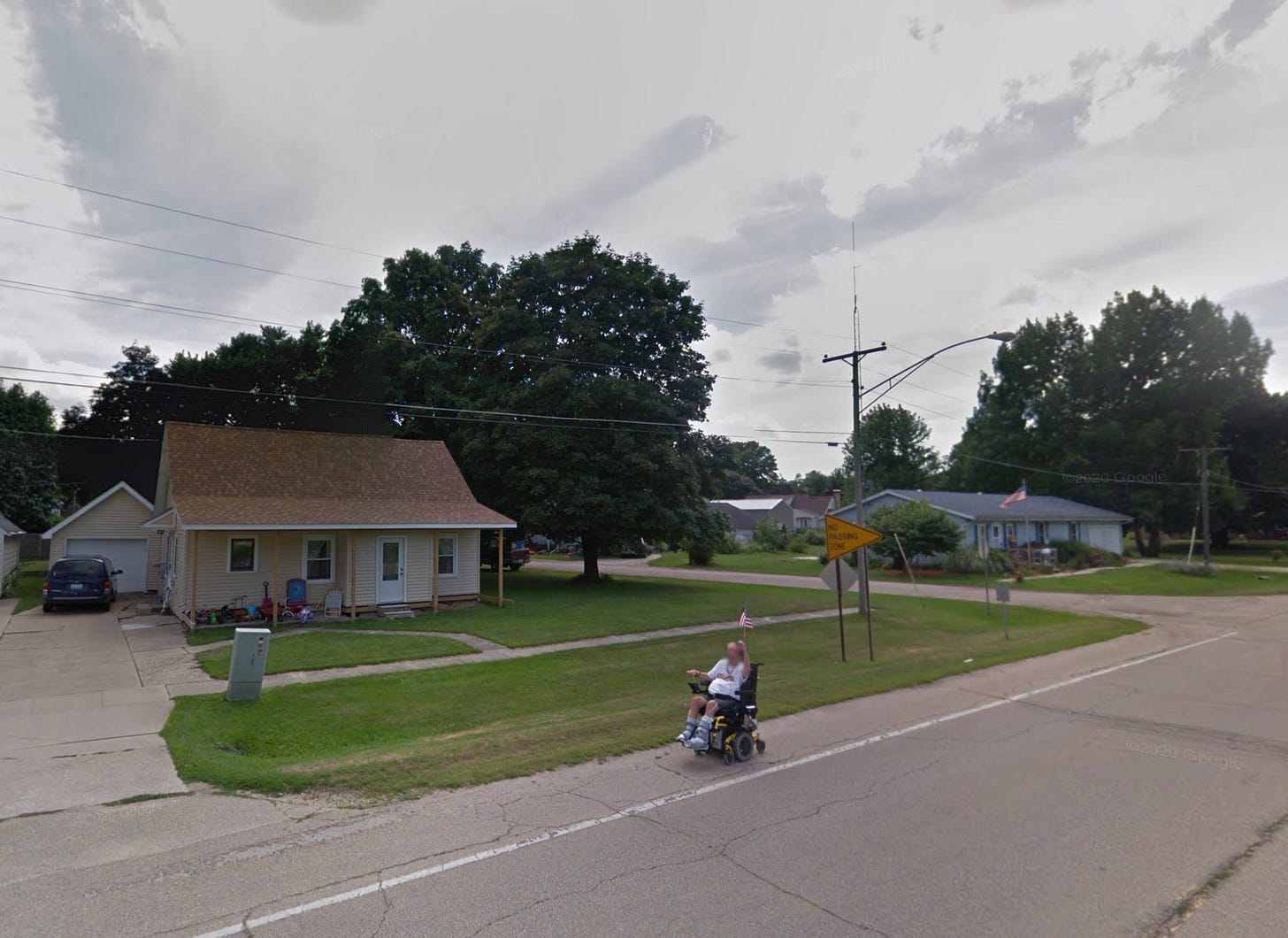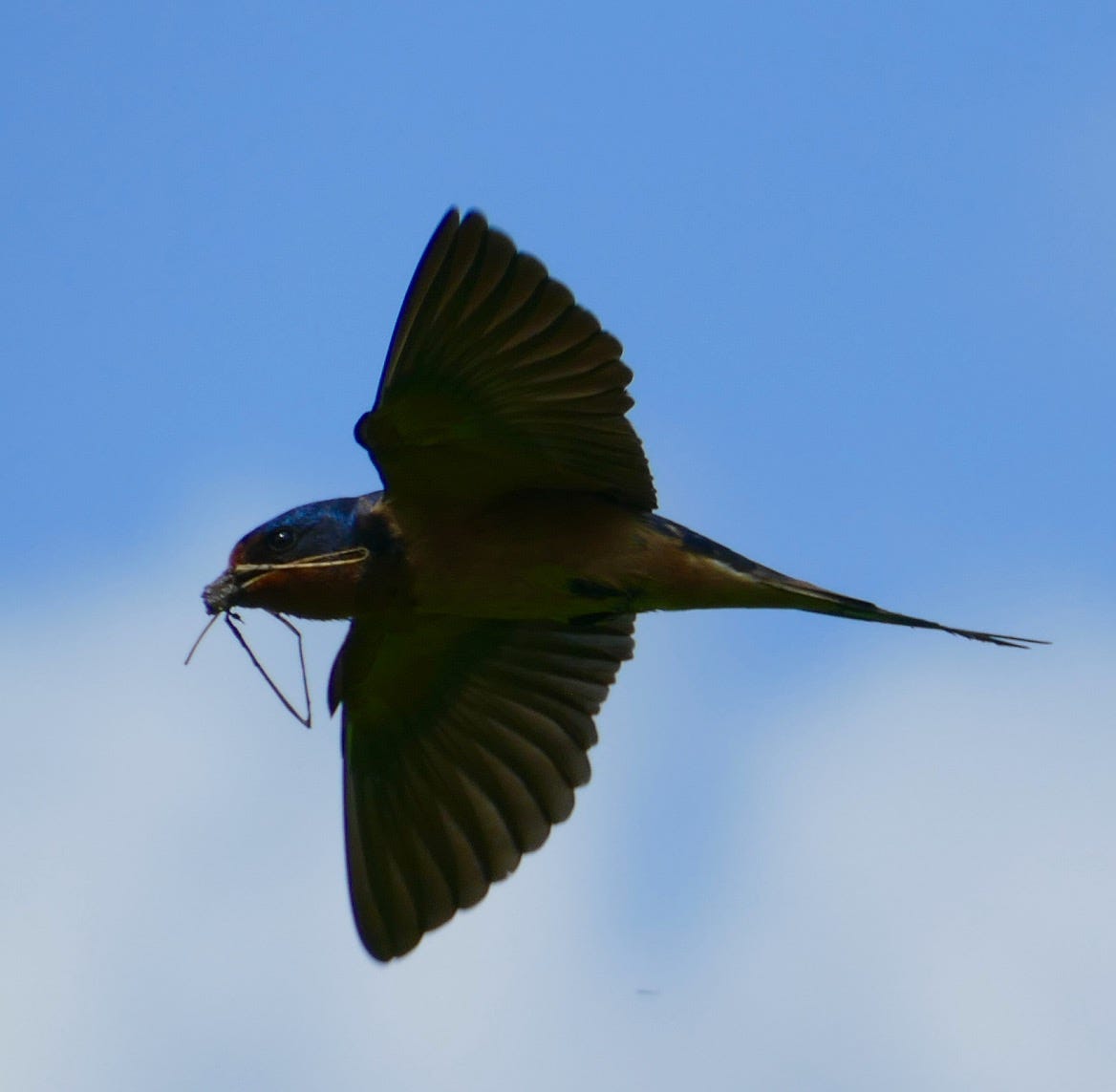The Curse of the Winnebago Prophet
Some field notes from a Midwestern long weekend
There’s a riverfront state park outside the Quad Cities that occupies the site where a band of Sauk Indians lived until their village was destroyed in 1832 by a volunteer Illinois militia. If you go to the website for the park, you will find a picture of a happy American family chilling outside their Winnebago, presumably unaware that the spot where they are vacationing was the home of a medicine man best known to history as the Winnebago Prophet.
In the language of his people, Wabokieshiek’s name evoked the white light in the sky, and the prophecy for which he is remembered was the premonitory assurance he gave Black Hawk that the British and other tribes like the Ho-Chunk and the Potawatomi would come to his aid if he rose up to seek justice and fair dealing from the American settlers who had tricked the tribes in a bad real estate deal. It didn’t turn out that way, and the area around Wabokieshiek’s home is now a main street called Prophetstown, known for its classic car cruises and July 4 fireworks.
The Corn Belt is a land built on bad predictions of better futures, which makes you wonder how much you should really entrust your risk management needs to the actuaries the black soil grows in surprising numbers alongside its ample crops of soybeans and “the other white meat.” Maybe it’s the distorted lens of the dystopian novelist that always makes me see my Midwestern home country through a Mad Max mirror, a landscape of small towns founded on utopian dreams that have mostly devolved into depopulated zones of economic and ecological exhaustion.
It’s not due to any failure of the character of the people that live there. It’s a design flaw of the idea of every household being a semi-autonomous machine for the extraction of surplus from the land. On this trip to see my folks I found my old copy of Crèvecœur’s Letters From an American Farmer on the shelf, and was reminded how he saw the illusory promise of that family farm model of civilization before the USA even came into existence, in an epistolary narrative of decline as the Frenchman’s initial joy and wonder at the American experiment shifts to a pessimistic reckoning with the horrors of slavery, conquest and colonization.
The immanent darkness is there in those Grant Wood paintings you know, which also capture the green beauty of that land between the Mississippi and the Missouri. Contemporary Iowans like to talk about how the coastal critics ridiculed Wood as some kind of 1930s version of a pop surrealist, only because they didn’t understand that his almost cartoonishly rolling hills were what the place really looked like. The locals are less likely to note the radical critique lurking behind the wry snark of Wood’s portraits.
Twenty-five percent of the Grade One agricultural land in the United States is in Iowa, or was as of the time the WPA published its guide to the state in 1938. The black dirt is the product of four great glaciers that covered much of the state from fifty to twenty-five thousand years ago. In the northern part of the state, which the glaciers left as flat as your kitchen table, corporate farming has evolved in partnership with biotech and robotics to yield a kind of agribusiness paradise, as old fencerows disappear to make room for the big machines that can cultivate and harvest fields of grain monoculture that span whole townships, expressing economies of scale unimaginable to the forty-acres-and-a-mule stakeholders who first settled those parts.
The county my parents retired to is outside the zone of glacially endowed bounty, washboard woodland better suited to cattle ranching. The population peaked in 1920, and a century later is half what it was then. Culturally, it has always felt like the place where a little bit of Appalachia leaked into otherwise orderly Iowa. And when you go there now, everywhere you look you see signs of rewilding. Sometimes on purpose, but more often by accident, or abandonment.
When we left the highway and followed the gravel road to their place, we saw that the old red barn across the road, where they used to raise ponies people could order by mail from the Sears catalog, has finally collapsed. Further up the road we passed a long windowless building that appeared a few years ago. There was something creepy about it when I first saw it, and when I asked about it, I learned that it is, in essence, a concentration camp for chickens. Amazing how quickly you get used to such a thing, able to drive on by without even noticing it.
A new agri-industrial facility like that is anomalous up there. Half the other homesteads on that road are overgrown ruins now, including the house I once visited in the eighties to see the collection of arrowheads its owner, the grandson of the settlers who came there from Vermont, had collected from the creek as a boy before the war. The highest and best use of most of the land in that county now is as hunting refuges, mostly for wealthy Southern men who fly up for weekends of whitetail and wild turkey. The locals have pejorative nicknames for those guys, but they take their money. And in those transactions, you see how feudal the social structure really is, and how misdirected the populist political rage of that region has become since the days of the Grange.
My folks’ place is more ecotopian—a 200-acre oak savanna they have been restoring since the 80s, mainly with annual controlled burns. The resulting biodiversity is remarkable, and at its most beautiful this time of year, when the wildflowers bloom under the bright green canopy, and the ticks don’t seem to be out yet. On Saturday after my son and daughter-in-law arrived, we followed my mother down into the columbine, and you could see how deeply of that place she has become, and how much the place reflects her own unmediated connection with the land. Every time I go up there I am more convinced that she is evolving before my eyes into some Tolkienesque forest creature who will live for a few hundred years, outlasting the coming apocalypse. Maybe that’s what the real utopian future looks like—a rewilded planet sparsely populated with a few human attendants.
On this trip I noticed how even their house is becoming rewilded. The sparrows have begun to take over the stucco with their mud nests under the overhangs, flying around the yard in flocks as thick as the ones we have here under our urban bridges over the Colorado. Red-winged blackbirds, the most aggressively territorial songbirds I have ever encountered, control the perimeter. The beams holding up the outdoor stairs to my dad’s studio have been colonized by insects who have made labyrinthine tunnels between the grain, leaving just enough structure to hold the weight when he walks up. The tree frogs are on the windows, and the predators walk right out of the woods to the house, like the bobcat I once saw gutting its fresh kill outside the kitchen door.
As beautiful as my parents’ refuge is, I am always reminded when I visit how, in this country, you can’t really go for a walk in the country. The absence of the right of trespass that Continental Europeans enjoy is surely one of the main reasons our experience of nature in the U.S. is so focused on public parks and official wilderness areas. Wandering across the rural landscape is not permitted, and deep in the heart of the heart of the country, even the public roads are not really paths where visitors are welcome. As I was reminded on a weekend jog down the long driveway to find my path blocked in both directions by loose hounds—one trio on the bridge over the creek that looked surprised to see a guy in shorts intruding upon their midday prowl, and another one down the road who was excited by their barking at me.
In their warily predatory stares, I thought I was seeing another glimpse of the future, maybe because I felt I had conjured them with the fictional scene I had been writing the week before of a similar such encounter in the rewilded periphery of a mid-21st century American city. I saw a few feral cats on this trip, too. But dogs who have escaped our control and begun to compete with us for territory and food always make me think how tenuous our dominion is, in this civilization founded on our control of the reproduction of other species, and of each other. In Texas the feral hogs have already begun to retake the golf courses of suburbia. Maybe the other farm animals are next.
The next evening when my dad and I returned from an airport run, we encountered a teenage girl riding a big horse down that same stretch of road that I had seen as a no-go zone. Another visitor, evidently, appearing to us as a beautiful apparition. Whether of my dad’s anachronistic small town past or my Romanticized apocalyptic future, I’m not sure.
Our toddler daughter remained firmly grounded in the present during our visit, if not always on the ground, as I wondered what the American country will look like when she is my age. The future that’s represented by rewilded swaths of the rural landscape is “unevenly distributed” in more than temporal ways, but it’s a lot more hopeful than the future represented by that sci-fi chicken coop.
When we got back to our home in Austin after our first plane trip since 2019, we found our experiment in urban rewilding had gotten its jungle on. A month of good rain had helped the native grasses get going earlier than usual, and the green carpet was dolloped with the brighter colors of winecup, horsemint, and coneflower. The sawtooth sunflowers my son and I transplanted the weekend before, which looked pretty at risk when we left, had almost fully recovered and revealed in the expression of their leaves the origins of their name.
Not far from that patch, the buffalo gourd had sprawled its long vines out over the concrete debris dumped here before we arrived, leaves like the ears of little elephants pointed up to catch the rain. The flowers look a lot like zucchini blossoms, and soon they will bear their hard yellow fruit the size of softballs. There are no more mastodons wandering through to nibble on them, but the squirrels seem to do a passable job of spreading their seed.
Long weekend reading
“I come from Des Moines. Somebody had to.” That’s the memorable opening of Bill Bryson’s The Lost Continent, which is pretty funny, but not the best writing about Iowa I have read. That would be The WPA Guide to 1930s Iowa. Like all the WPA guides, it contains a bunch of Depression-era driving tours annotated with amazing local stories collected by the unemployed writers the WPA retained to author the book, many of them bits of local lore from the period of settlement that have no other record.
My favorite is the bit about the township of New Buda, founded down the road from my parents’ place by Hungarian aristos who fled after their failed 1848 uprising against the Austrians. In Southern Iowa they built a big lodge, planted tobacco and wine grapes, and planned a grand urban project. Unfortunately, none of them had ever done any real work, and spent most of their time hanging out “studying maps and discussing world affairs.” The last of the New Budans, a military officer named Pomutz, rode across the prairie on a white mare named Highland Mary pitching his plans for a new metropolis. After a distinguished career fighting our own rebels in the Civil War, he was appointed U.S. Consul to Russia. When he died in St. Petersburg sixteen years later and the strongbox he had brought his valuables was opened, it contained his only assets—the blueprints and papers for an imaginary city.
You can find that story here in the free online Archive.org copy of the Guide. And you can find the WPA guides to all the other states at your local library, or in reprinted paper copies from Trinity University Press.
If you have never read it, J. Hector St. John de Crèvecœur’s 1782 Letters from an American Farmer; Describing Certain Provincial Situations, Manners, and Customs not Generally Known; and Conveying Some Idea of the Late and Present Interior Circumstances of the British Colonies in North America is available for free online at Project Gutenberg.
For a fascinating reframing of the relationship Native Americans had with the land before the arrival of Europeans, including their use of fire to amp up the biological yield of the prairies, check out Shepard Krech III’s The Ecological Indian.
Wikipedia has a good roundup of the different regimes governing the circumstances in which you can, depending on the country, walk across your neighbor’s field or risk getting legally shot.
And farther afield, the May 24 issue of The New Yorker has a fascinating piece by Rebecca Mead on the Cerne Abbas Giant in Dorset, and other English geoglyphs.
Lastly, here’s some of that columbine my mom led us to. Also known as granny’s bonnet, I now see, which is the name I will have to teach our daughter.
Enjoy the three-day weekend, if your schedule permits, and have a safe week.















Chris, easily my favourite field notes to date. When I think about the qualities of the US that I admire, many of them are reflected this post. Two re-wilded thumbs up 👍🏼 🌲
My wife and I have lived 35 years in northeast Iowa, but industrial agriculture is driving us out. As you mention, our best plan for escape is selling our farm as a private hunting lodge/preserve in this part of the state.
CAFOs (Concentrated Animal Feeding Operations) combined with GMO corn have made the state's surface waters the most polluted in the nation. The soil is lifeless, just a medium to hold rowcrops in place, because anhydrous ammonia fertilizers and herbicides/pesticides have eliminated all life right down to microbial level. Iowa's air quality is putrid; due to CAFOs, the state reeks of hog manure. The agriculture industry owns the state legislature, which has cut regulation and oversight of environmental quality for more than 30 years.
Some isolated islands of land in the state (and the inhabitants thereof) may be a Tolkienesque Shire, but most of Iowa has become Mordor. All of the corn belt has become a poisoned environment - stretching across parts of Ohio, Indiana, Illinois, Wisconsin, Minnesota, Nebraska, South Dakota - but Iowa is the worst.
As a consequence, Iowa's small towns are now a stark portrait of poverty, and residents of rural counties are bewildered as to how this all came about. Desperate and clueless, six of 10 voters cast their ballot for President Orange and his promise to Make American White Again - because somehow this is all the fault of the Mexicans and the Blacks.
We have to get out of this state while getting out is still possible.